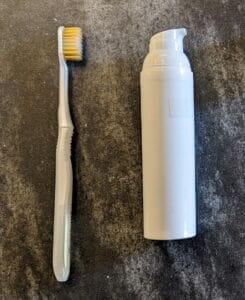
Along with clean teeth, a specially formulated toothpaste may help increase tolerance to peanut in those with peanut allergy, a small study finds.
The experimental toothpaste, which contains small amounts of peanut protein, is being developed by Intrommune Therapeutics as a potential new peanut allergy treatment. The aim is to gradually increase the amount of peanut someone can consume without a reaction by exposing them to peanut protein during daily brushing.
The process is called oral mucosal immunotherapy, or OMIT. It’s a similar concept to oral immunotherapy (OIT), in which people eat gradually increasing amounts of their allergen over the course of several months.
The difference with teeth brushing is that the toothpaste is not meant to be swallowed, explains Dr. William Berger, an allergist-immunologist and consultant for the New York-based biotech company.
Instead, brushing with the toothpaste interacts with a type of immune system cell found throughout the mouth to peanut protein. Called Langerhans cells, in the mouth they are found in the mucosal lining of the gums, tongue, inside of the cheeks and palate.
Langerhans cells alert other immune system cells to antigens, or foreign substances – in this case, the peanut protein. “This leads to an immunologic reaction that stimulates the production of IgE-blocking antibodies, called IGG4. Producing IGG4 blocks the allergic reaction, leading to desensitization,” Berger says.
Phase 1 Trial of Allergy Toothpaste
The company recently released its first study, a Phase 1 trial involving 32 adults ages 18 to 55, during the 2023 American College of Allergy, Asthma and Immunology annual meeting in Anaheim. The trial was aimed at testing the safety of the approach.

Before the trial, participants underwent a food challenge. To be enrolled, they had to start to react to 100 milligrams (mg) or less of peanut, or about one-third of a peanut.
Participants then brushed daily with the toothpaste, called INT301, or a placebo, for 48 weeks. The toothpaste was mint-flavored, and neither group knew which one they were in, Berger says.
Participants set a timer to make sure they brushed for a full two minutes, as well as thoroughly in all areas of their mouth. They then rinsed normally with water.
The toothpaste is dispensed in metered doses to ensure participants use the right amount, and they used a toothbrush with soft bristles. The starting dose was less than 1 mg, which increased every two weeks to a maximum dose of 80 mg, which they stayed on for maintenance.
Mild Side Effect
Side effects included mouth itchiness or tingling, but this was mild and went away quickly. No one dropped out of the study due to reactions, he says.
For safety reasons, people with significant gum disease or who planned to get dental surgery were not included in the study. Gums that are open or inflamed could give the allergens direct access to the bloodstream, increasing the risk of reactions.
Although the Phase 1 study in adults was meant to look at safety, three participants who had reacted to under 100 mg of peanut at the start of the trial underwent a food challenge after the 48 weeks. All had increased their tolerance and could consume at least 300 mg of peanut before starting to react.
“We did get a signal for effectiveness and as a result we feel very, very comfortable moving forward in terms of a pediatric trial,” Berger says.
Allergy Toothpaste and Kids
Next steps are studying the toothpaste in children ages 4 to 17 with peanut allergy. That should start enrolling in mid-2024, Berger says. Intrommune Therapeutics may use a bubble gum or watermelon-flavored toothpaste to make sure kids are willing to brush.
One concern with children could be swallowing the toothpaste, leading to reactions. Because even the maximum dose of the toothpaste contains only small amounts of peanut protein, the risk of major reactions is low, he says.
Future trials may test toothpastes containing other allergens, Berger says.
Current Immunotherapy
Children with peanut allergy currently have only one FDA-approved immunotherapy option, Palforzia. With that medication, kids consume precise amounts of peanut powder mixed into food every day, in gradually increasing amounts.
After the build-up phase with Palforzia, children stay on a maintenance dose indefinitely to maintain tolerance.
A toothpaste could make it easier for people to stick with immunotherapy because it doesn’t require any special preparation, Berger says. Their toothpaste is “fully functional.” It removes plaque and freshens breath just like a regular toothpaste.
“It’s a part of their normal daily routine, as a part of brushing their teeth,” he says. “In the morning, you’d use this toothpaste. At night, you’d use your regular toothpaste.”
Another immunotherapy treatment, sublingual immunotherapy (SLIT), delivers small doses of allergens through under-the-tongue liquid drops or tablets. In the U.S., the only forms of SLIT approved by the FDA are tablets for certain environmental allergens, including ragweed, dust mites and some grasses.
Berger says the immune cells targeted by the toothpaste aren’t just present under the tongue, but are found all over the mouth. “What the brushing of the teeth does is exposes the entire oral cavity to the allergen,” he says.
Related Reading:
OIT Formula for Multiple Allergens Shows Promise in Early Results
Strong Results for SLIT Therapy Seen in Peanut-Allergic Toddlers
‘Very Low-Dose’ Peanut Oral Immunotherapy Helps Desensitize





